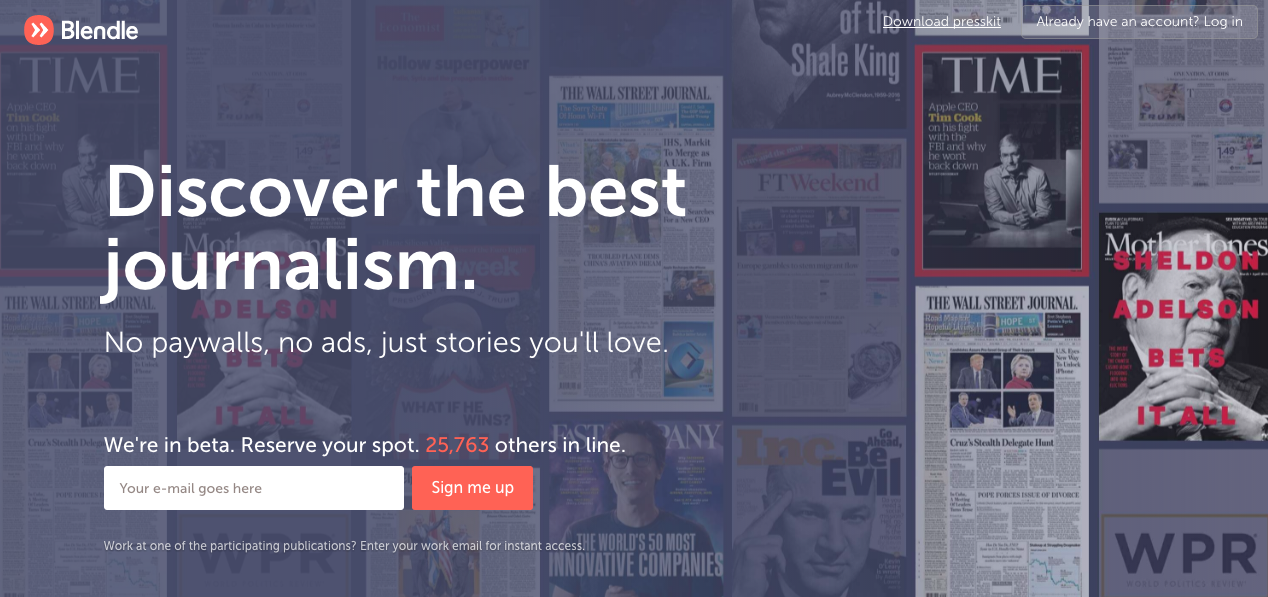You might have noticed a resurgent buzz lately about one of journalism’s oldest digital revenue schemes: micropayments.
The idea of charging small amounts of money — generally between 10 and 90 cents — for individual articles has been around since the birth of the internet. But with online advertising revenue increasingly threatened by ad blockers, or being siphoned away by social media platforms like Facebook and Twitter, micropayments are receiving renewed interest from news publishers seeking to diversify their revenue.
In March, the New York Times, the Wall Street Journal, the Washington Post and Time were among 20 U.S. publishers to partner with Blendle, a Dutch-based platform that recently surpassed 1 million global users. Meanwhile, the newest contender in the “micropayment war” is Tibit, which boasted in June that publishers and users “will prefer us to Blendle.”
There’s still plenty of skepticism within journalism circles that online audiences — having been groomed to receive content for free — will consent to paying anything, even a few dimes, for news online. But given the mixed results of paywalls and the plight of digital advertising, champions of the micropayment approach argue it might be journalism’s best hope for a sustainable revenue model.
Here’s an overview of the three platforms with the best chance to make micropayments stick around.

Photo by Tom Small and used here with Creative Commons license.
Blendle
Founded in 2014 by Dutch entrepreneurs Alexander Klöpping and Marten Blankesteijn, Blendle hopes to become the iTunes or Spotify of journalism, a one-stop shop where users can browse and purchase stories from all their favorite publishers. The platform, which began with strong launches in the Netherlands and Germany, received a $3.8 million investment from the New York Times and Axel Springer in 2014 and launched in the U.S. earlier this year.
Blendle uses a combination of human editors and algorithms to curate the best stories from across its partner network and takes a 30 percent cut from all sales. A new feature, the Blendle Premium feed, will offer personalized content streams “compiled to each of our readers’ unique interests and tastes.”
Another of Blendle’s unique features is its immediate refund policy for readers who don’t think an article was worth their money. Only about 10 percent of purchases result in a refund, according to Ad Age.
With a million users and counting, Blendle is by far the largest micropayment platform on the web. And according to Newsweek, the company’s growth rate is “comparable to Spotify in its early years” — a good sign for Blendle and for the industry as a whole.
You can hear an interview with Blendle’s Alexander Klopping on the MediaShift Podcast, at the 10:00 minute mark:
Tibit
The “micropayment war” heated up in June, when Tibit, a London-based company, announced that its product is ready for market.
Unlike Blendle, Tibit won’t collect micropayments through its own third-party distribution platform. Instead, Tibit will allow users to make small donations — or “tibs” — directly on a publisher’s website. For publishers with paywalls, users may also be able to use “tibs” to unlock access to premium content.
Tibit is actively seeking partnerships with media publishers, but to keep pace with Blendle, it will likely need to attract deep-pocketed investors in a hurry. As of June, Tibit had raised only $175,000 through crowdfunding and about $150,000 from private investors — a relatively small war chest for a company that’s playing catch-up.

Tibit is the newest micropayment platform on the market.
Flattr
Launched in 2010, Flattr allows users to set a monthly contribution budget, which is then distributed to publishers that they “flattr.” The platform has struggled to catch on, especially among major publishers, but a new partnership with AdBlock Plus could help its efforts to scale up. Together, AdBlock Plus and Flattr are launching Flattr Plus, a product that will be integrated with the ad-blocking tools already used by millions of people online.
The other major innovation of Flattr Plus is that it doesn’t require users to click a button to trigger payments. Instead, as TechCrunch explains, Flattr Plus will “automatically track their browsing activity and distribute the money based on their engagement.” (This is same approach used by Tipsy, an open-source Chrome browser extension that has not been widely adopted).
Despite concerns that publishers will balk at Flattr’s partnership with an ad-blocking leader, the two companies have set high expectations for year one. According to a story in Fortune, their goal is to generate $500 million for publishers in 2017 — a total that would make Flattr Plus a serious player in journalism’s growing micropayment sector.
Ben DeJarnette is the associate editor at MediaShift. He is also a freelance contributor for Pacific Standard, InvestigateWest, Men’s Journal, Runner’s World, Oregon Quarterly and others. He’s on Twitter @BenDJduck.

